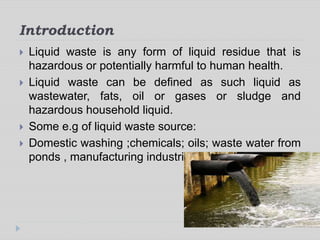8 Simple Techniques For Reclaim Waste
8 Simple Techniques For Reclaim Waste
Blog Article
Reclaim Waste for Beginners
Table of ContentsThe Reclaim Waste StatementsHow Reclaim Waste can Save You Time, Stress, and Money.The Definitive Guide to Reclaim WasteThe Greatest Guide To Reclaim WasteSome Known Incorrect Statements About Reclaim Waste
Explore the kinds, incidents, and types of liquid waste. Residential sewer waste describes the waste and products from a residential septic container. This sort of waste is created by human beings in houses, schools, and various other buildings. This only includes septic storage tanks that have a drain field. The proper monitoring and disposal of domestic sewer waste need liquid waste to be transferred to a sewer treatment plant where the correct methods and tools are applied to detoxify and dispose of waste.
Commercial waste typically includes prospective dangers, such as combustible materials or a combination of fluid and solid waste products, and needs an advanced and in-depth disposal procedure. The disposal of business waste usually entails the filtration of waste before transport to ensure risk-free and correct disposal. Industrial waste is created from results and drainage of commercial processes and production.
This type of waste can not utilize the very same sewage administration transportation or processes as septic or industrial fluids. The hazardous waste administration procedure calls for the inspection and testing of liquid waste before it undergoes the disposal process (liquid waste disposal). Drainage waste is the fluid waste that originates from drainage and excess stormwater in very booming locations or cities
Runoff waste can create contamination and flooding if not taken care of effectively. Making sure appropriate waste administration can avoid disasters and reduce ecological damage.
Excitement About Reclaim Waste
Contact PROS Solutions today to find out about our waste administration and disposal services and the appropriate ways to take care of the liquid waste you create.
(https://www.storeboard.com/reclaimwaste2)This so-called 'wastewater' is not just an important source but, after therapy, will be released to our land, rivers or the ocean. Used water from bathrooms, showers, bathrooms, kitchen sinks, washings and commercial processes is understood as wastewater.

water made use of to cool equipment or tidy plant and devices). Stormwater, a kind of wastewater, is overflow that streams from agricultural and metropolitan locations such as roofs, parks, yards, roads, paths and rain gutters into stormwater drains, after rainfall. Stormwater moves without treatment straight to neighborhood creeks or rivers, eventually reaching the sea.
The 6-Minute Rule for Reclaim Waste
In Queensland, the majority of wastewater is treated at sewage therapy plants. Wastewater is moved from domestic or industrial websites through a system of drains and pump terminals, understood as sewerage reticulation, to a sewer treatment plant.
The Department of Natural Resources suggests neighborhood governments concerning managing, operating and maintaining sewage systems and treatment plants. In unsewered locations, city governments might need homeowners to set up specific or home sewage treatment systems to treat domestic wastewater from bathrooms, kitchen areas, bathrooms and washings. The Department of Natural Resources authorizes the usage of household systems when they are shown to be effective.
Most stormwater obtains no treatment. In some new communities, therapy of some stormwater to remove litter, sand and crushed rock has actually begun using gross contaminant traps. Wastewater treatment takes place in 4 stages: Gets rid of strong matter. Bigger solids, such as plastics and other objects mistakenly released to sewers, are eliminated when wastewater is gone through displays.
Utilizes small living microorganisms recognizes as micro-organisms to damage down and eliminate staying liquified wastes and great fragments. Micro-organisms and wastes are incorporated in the sludge.
The Main Principles Of Reclaim Waste
Nutrient elimination is not readily available in any way sewage treatment plants click for more info since it requires costly specialized equipment. It is ending up being more common in Queensland. Clear liquid effluent produced after treatment might still have disease-causing micro-organisms. If this effluent is released right into rivers such as rivers or the sea, the micro-organisms will ultimately die out.

A lot of wastewater flows right into the sewage system. Under the Act, local federal governments administer authorizations and licences for eco appropriate activities (Ages) involving wastewater launches that might have a local effect.
Reclaim Waste Can Be Fun For Anyone
Otherwise, samples are considered laboratory analysis. Frequently many tests are needed to establish the levels of each of the various toxins such as oils, hefty metals and pesticides in water. Tracking supplies factual details concerning water top quality and can validate that permit conditions are being fulfilled. The details gotten via surveillance supplies the basis for making water high quality choices.
Report this page